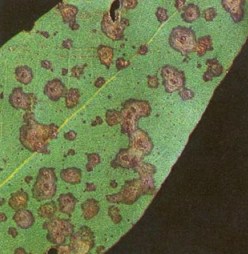PESTS AND DISEASES OF FORESTRY IN NEW ZEALAND
Trimmatostroma Leaf Spots of Eucalyptus
Scion is the leading provider of forest-related knowledge in New Zealand
Formerly known as the Forest Research Institute, Scion has been a leader in research relating to forest health for over 50 years. The Rotorua-based Crown Research Institute continues to provide science that will protect all forests from damage caused by insect pests, pathogens and weeds. The information presented below arises from these research activities.
8 & 9. Trimmatostroma Leaf Spots of Eucalyptus spp.,
Forest Pathology in New Zealand No. 1.
Fungi
Trimmatostroma bifarium Gadgil and M. Dick
Trimmatostroma excentricum Sutton and Ganapathi
Type of injury
Leaves become disfigured but tree growth is not usually affected. Heavy infestations, which are rare, may cause premature leaf drop or reduce photosynthesis.

Fig. 9 - Trimmatostroma bifarium on Eucalyptus regnans .
Diagnostic features
This description is applicable to both species as they cannot be distinguished in the field. Brown, roughly circular (2-18 mm in diameter) spots, frequently composed of concentric rings of different shades of brown. Lesion centre often raised and with a crusty appearance. Small, black dots (the fruiting structures) visible on the spots. Caution : These leaf spots look similar to those caused by Aulographina eucalypti. However, the lesions caused by Trimmatostroma spp. go right through
the leaf and the same lesion can be seen on both sides, whereas Aulographina lesions are generally limited to one surface of the leaf.
Hosts
Trimmatostroma bifarium: Eucalyptus delegatensis, E. fastigata, E. fraxinoides, E. nitens, E. obliqua, E. regnans, E. sieberi.
Trimmatostroma excentricum: Eucalyptus delegatensis, E. fastigata, E. obliqua, E. pauciflora subsp. niphophila, E. regnans, E. sieberi.
Distribution
From central North Island to Southland.
Disease development
Spores are formed on the surface of the lesions in black powdery masses which are frequently arranged in a circular pattern. They are wind-dispersed and are found throughout the year.
Infection levels tend to be greatest in the lower crown. New season's leaves do not become infected until mid- summer.
Economic importance
Cause little damage.
Control
Not considered necessary.
Bibliography
Dick, M. 1982: Leaf-inhabiting fungi of eucalypts in New Zealand. New Zealand Journal of Forestry Science 12 : 525-537.
Dick, M. 1990: Leaf-inhabiting fungi of eucalypts in New Zealand. II. New Zealand Journal of Forestry Science 20 : 65-74.
Dick, M.; Gadgil, P.D. 1983: Eucalyptus leaf spots. New Zealand Forest Service, Forest Pathology in New Zealand No.1.
Gadgil, P.D. 2005: Fungi on trees and shrubs in New Zealand. Fungi of New Zealand Volume 4. Fungal Diversity Research Series 16: 1-437
Ridley, G.S., Dick, M. 2001: An introduction to the diseases of forest and amenity trees In New Zealand. Forest Research Bulletin 220, Rotorua, New Zealand
Compiled: 1983, minor update 1990, revised 2009
This information is intended for general interest only. It is not intended to be a substitute for specific specialist advice on any matter and should not be relied on for that purpose. Scion will not be liable for any direct, indirect, incidental, special, consequential or exemplary damages, loss of profits, or any other intangible losses that result from using the information provided on this site.
(Scion is the trading name of the New Zealand Forest Research Institute Limited.)

 Farm Forestry New Zealand
Farm Forestry New Zealand

